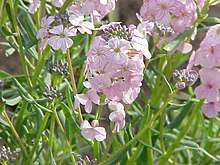Aethionema grandiflorum
Aethionema grandiflorum, commonly known as Persian stonecress or Persian candytuft, is a flowering plant in the family Brassicaceae, preferring to grow at 750 to 2600 m on limestone slopes. It is sometimes kept as a garden plant, and occasionally naturalizes outside its original range of eastern Turkey, the southern Caucasus and northern Iran. It is a recipient of the RHS's Award of Garden Merit.[2]
| Aethionema grandiflorum | |
|---|---|
 | |
| Scientific classification | |
| Kingdom: | Plantae |
| Clade: | Tracheophytes |
| Clade: | Angiosperms |
| Clade: | Eudicots |
| Clade: | Rosids |
| Order: | Brassicales |
| Family: | Brassicaceae |
| Genus: | Aethionema |
| Species: | A. grandiflorum |
| Binomial name | |
| Aethionema grandiflorum | |
| Synonyms | |
| |
Description
Aethionema grandiflorum is a many-stemmed, short-lived perennial, typically forming 15 to 30 cm (at most 40 cm) tall spreading mounds. Its foliage is evergreen, and it has up to 15 pink to lilac cruciform flowers borne on terminal racemes.[3] It prefers alkaline soils.

Foliage
gollark: https://www.reddit.com/r/rust/comments/5penft/parallelizing_enjarify_in_go_and_rust/dcsgk7n/I think this just wonderfully encapsulates Go.
gollark: Oh, it also has that weird conditional compile thing depending on `_linux.go` suffixes or `_test.go` ones I think?
gollark: Okay, sure, you can ignore that for Go itself, if we had Go-with-an-alternate-compiler-but-identical-language-bits it would be irrelevant.
gollark: I can't easily come up with a *ton* of examples of this, but stuff like generics being special-cased in for three types (because guess what, you *do* actually need them), certain basic operations returning either one or two values depending on how you interact with them, quirks of nil/closed channel operations, the standard library secretly having a `recover` mechanism and using it like exceptions a bit, multiple return values which are not first-class at all and which are used as a horrible, horrible way to do error handling, and all of go assembly, are just inconsistent and odd.
gollark: And inconsistent.
References
- P. E. Boissier, Diagn. pl. orient. ser. 1, 8:42. 1849
- " Aethionema grandiflorum Persian stone cress". RHS. Retrieved 16 August 2019.
- Moazzeni, Hamid; Al-Shehbaz, Ihsan A.; German, Dmitry A.; Assadi, Mostafa; Müller, Jochen; Joharchi, Mohammad Reza; Memariani, Farshid (18 June 2018). "A taxonomic revision of the genus Aethionema s.l. (Brassicaceae) in Iran". Phytotaxa. 356 (4): 241–266. doi:10.11646/phytotaxa.356.4.1.
This article is issued from Wikipedia. The text is licensed under Creative Commons - Attribution - Sharealike. Additional terms may apply for the media files.